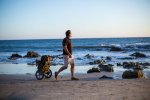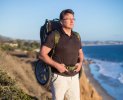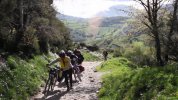Slow down please. I just expressed a qualified opinion based on 40 years + experience of walking on differing terrains. I have no experience of using a trailer, but speculated that the extremely rutted surface could cause problems. If I’m wrong on this I accept my error, but please don’t take it as an attack trailer users. I was just pointing out that this is one of the most uneven sections on the CF.
I wish to apologise, have deleted my comment - apologies. It is just that I have been getting frustrated by this for so many years. People who have never used a trailer always think that is heavy, difficult, hard to manoeuvre, unable to go on rough terrain, etc - but all of this is completely untrue.
When the US military did fully combat loaded field tests with trailers they found that energy expenditure was reduced by 84% - 84% !!
The problem on very rough surfaces and ascents and descents rests with those wearing a heavy pack, not towing a trailer, as they are top heavy, unbalanced, they have extra weight and stress on every bone and muscle and ligament from the waist down. If they trip they fall, if they become unstable they fall. They are prone to ankle and knee injuries.
Whereas with a two wheeled trailer (not the monowheel as they are a ghastly unstable design. leaving half the weight on the body) the body carries no huge extra weight at all so is limber and lithe, well balanced, no stresses on limbs, upright relaxed walking ... the trailer is connected to a padded hip belt with drawbars that rest forward of the body ... they are balanced to leave less than half a kilo on the hips, just enough to stop it rocking up and down but be stable ... it has wheels so the trailer isn't pulled over rough ground, it rolls through and over it ....
It takes literally 90 seconds of trying a trailer to get the lightbulb Ah! moment and realise how wonderful they are.
The wheelbase is no wider than shoulders so anywhere a person can walk so can a person with a trailer.
You don't sweat, don't get exhausted, don't get leg, ankle, feet, hips, shoulder problems.
So when I read from anyone who has never ever used a trailer, or probably not even seen one, that a certain section cannot be done with a trailer I get both frustrated and irritated and I mistakenly allow that to spill out.
I say again, I don't know of any section on the
Camino Frances that is a problem with a hiking trailer, though do agree that there are very rough sections - as mentioned above, those sections are regularly done by families with trekking buggies!!
All that said you cannot beat the laws of physics. If you walk up a hill from 1,000 feet to 1,500 feet the energy needed to move you up that 500 feet, body and pack, or body and trailer, is exactly the same as pushing it all up vertically 500 feet. The difference being that we 'alter our gearing', same as a bicycle, we take much shorter steps so rise in tiny increments. On the flat you are unaware that your trailer weighs anything at all, it is as if it is not there, but going up hills you are pulling it behind you, the weight of the load plus the weight of the trailer but is very easy and comfortable if short steps are taken. However, to wear a heavy pack going up that same hill is exhausting and much more debilitating.


























